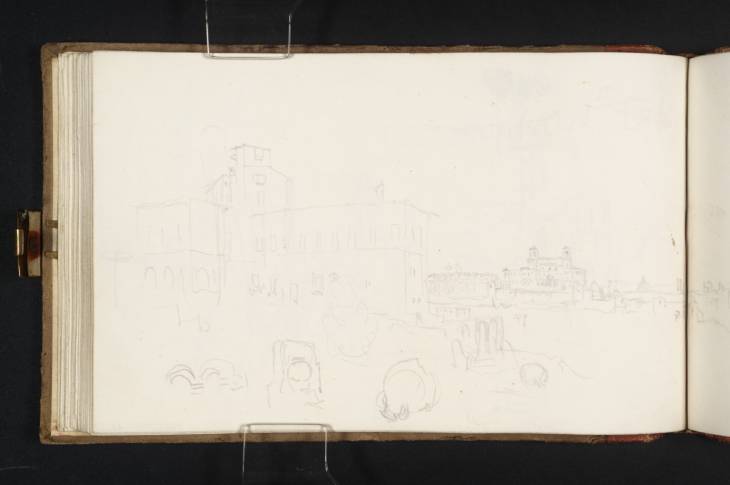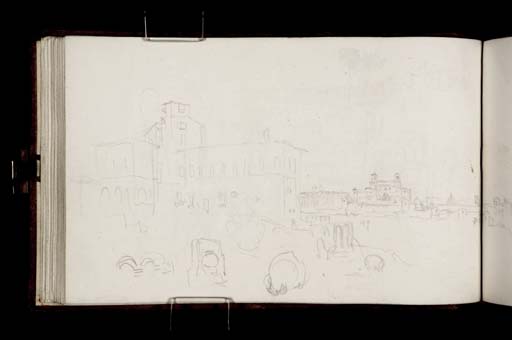Joseph Mallord William Turner The Casino di Raffaello, Rome, with a View of the Villa Medici 1819
Image 1 of 2
Joseph Mallord William Turner,
The Casino di Raffaello, Rome, with a View of the Villa Medici
1819
Joseph Mallord William Turner 1775–1851
Folio 46 Verso:
The Casino di Raffaello, Rome, with a View of the Villa Medici 1819
D16237
Turner Bequest CLXXXVIII 45 a
Turner Bequest CLXXXVIII 45 a
Pencil on white wove paper, 114 x 189 mm
Accepted by the nation as part of the Turner Bequest 1856
References
1909
A.J. Finberg, A Complete Inventory of the Drawings of the Turner Bequest, London 1909, vol.I, p.559, as ‘View from the Aventine’.
2009
Ian Warrell, ‘Painters Painted: The Cult of the Artist’, in David Solkin (ed.), Turner and the Masters, exhibition catalogue, Tate Britain, London 2009, pp.172–3 under no.63, 229 note 6.
2010
David Solkin and Guillaume Faroult (eds.), Turner et ses peintres, exhibition catalogue, Galeries nationales, Grand Palais, Paris 2010, pp.196, 262 note 17.
2011
Nicola Moorby, ‘Turner’s Sketches for “Rome from the Vatican”: Some Recent Discoveries’, Turner Society News, no.115, Spring 2011, pp.7, 9, 10 notes 29 and 37, reproduced fig.9, as ‘The Casino di Raffaello from the South-West, with Villa Medici and St Peter’s in the Distance’.
This sketch depicts the view looking south-west towards the Pincian Hill and the Villa Medici from the Casino di Raffaello, a summer-house near the grounds of the Villa Borghese, see folio 44 verso (D16233; Turner Bequest CLXXXVIII 43a). The drawing extends onto the opposite sheet of the double-page spread, see folio 47 (D16238; Turner Bequest CLXXXVIII 46). The Casino, destroyed during the siege of Rome in 1849, was one of a number of Roman sites popularly believed during the nineteenth century to have been connected to Raphael. This made it a celebrated landmark for artists and tourists to the city. The building is the subject of a celebrated painted tondo by Jean Auguste Dominique Ingres (1780–1867), Le Casin de Raphael 1806–7 (Musée des Arts Décoratifs, Paris) and a related drawing, c.1806–20 (Musée Ingres, Montauban).1 See also views by Jean-Baptiste-Camille Corot (1796–1875),2 Johann Wilhelm Schirmer (1807–1863),3 and Penry Williams (1802–1885).4.
Turner shared the fascination of the period with Raphael and sketched a number of Roman subjects owing to their supposed association with the artist, for example, the statue of Jonah in the Chigi Chapel, see folio 48 (D16240; CLXXXVIII 47), the façade of the Palazzo Vidoni-Caffarelli, see folio 64 verso (D16271; Turner Bequest CLXXXVIII 63a) and the Casa Cenci, another building in the Borghese Gardens popularly associated with Raphael, see folio 80 (D16302; Turner Bequest CLXXXVIII 79). The culmination of his interest was his large oil painting celebrating the tercentenary of the artist’s death, Rome from the Vatican exhibited 1820 (Tate, N00503).5 The composition of this sketch bears a strong resemblance to the so-called ‘Claudian’ landscape prominent in the foreground of the painting and inscribed along its lower edge, ‘Casa di Raffaello’.6 John Gage has furthermore noted a similarity between the painted depiction and a later vignette study inscribed ‘Raff Villa’ (see D27652 and D27659; Turner Bequest CCLXXX 135 and 142).7
Nicola Moorby
October 2008
See Hans Naef, Ingres in Rome, exhibition catalogue, National Gallery of Art, Washington 1971, pp.3 and 17, nos.1 and 21, reproduced.
Reproduced in colour in Anna Ottani Cavina, Un Paese Incantato: Italia Dipinta da Thomas Jones a Corot, exhibition catalogue, Galeries nationales du Grand Palais and Palazzo Te, Mantova, Italy 2001, p.240, fig.146.
See Raphael's residence in the Campagna di Roma in a letter dated 27 March 1827, Royal Academy of Arts, London, 04/1633, see http://www.racollection.org.uk/ , accessed February 2009.
How to cite
Nicola Moorby, ‘The Casino di Raffaello, Rome, with a View of the Villa Medici 1819 by Joseph Mallord William Turner’, catalogue entry, October 2008, in David Blayney Brown (ed.), J.M.W. Turner: Sketchbooks, Drawings and Watercolours, Tate Research Publication, December 2012, https://www


